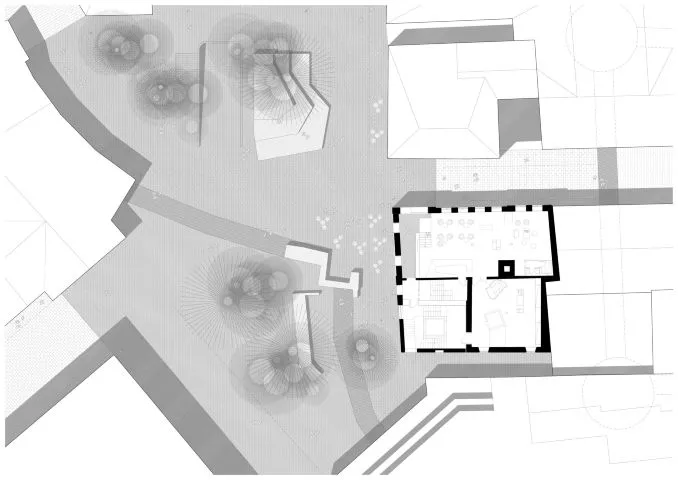Museum Tonofenfabrik

下载所需积分: 5
前托诺芬工厂位于德国拉尔历史中心,靠近中世纪城堡“斯托尔亨图尔”和中世纪城墙的遗迹。由于面临完全恶化的危险,这座被列为保护建筑的旧厂房被重新改造为城市博物馆,利用这一战略性城市位置,创造一个吸引游客和居民的目的地,以一种旧博物馆在城市公园中无法实现的方式,让人们与拉尔的历史和遗产产生联系。这座旧工业砖建筑不仅被改造成现代博物馆,而且不完整的“L”形体量通过新建的楼梯塔得以完善,形成了一个古老与现代相结合的和谐整体。
新建的红色混凝土楼梯塔不仅创造了一个无缝的展览循环,而且与现有建筑及其烟囱一起,将整体转变为一个高度可识别、几乎标志性的城市空间,迅速成为城市身份的重要组成部分。
除了在建筑内展示拉尔及其居民多层次的历史外,博物馆周围公共空间的重新开发也完成了城市整体,使拉尔中心的重要历史层面和结构重新变得可读。
建筑设计在街角打开了历史大门,创造了一个热情的入口,同时将一楼向城市广场扩展,利用北立面新开设的两个开口。这种城市与建筑之间的可渗透界面建立了城市内一个重要的目的地,不仅是博物馆,也是一个人们频繁聚会和举办活动的地方。
为了继续保持室内与公共领域之间的紧密联系,一楼主要设有公共空间,如前厅、咖啡馆和小型博物馆商店。此外,部分常设展览也在这个无需购票的区域展示,作为吸引人们进入的“开胃菜”,使城市的历史进一步进入公众视野。楼梯塔在建立清晰直观的流线方面发挥了重要作用,引导参观者穿过展览,并通过红色混凝土外立面的形式表现与外部的联系。
在博物馆内,两种对立的设计理念特征化了设计:历史工业建筑中的展览区域经过细致修复,旨在最大限度地保留现有结构及其特征。重点在于展示展览中丰富多彩的文物,由MuseoConsult和Studio Kernland设计。
新建的流通空间以其流畅的有色混凝土与锐利的金属栏杆和天花板几何形状相结合,延续了外部外观的形式语言,并在展览的明亮白色房间之间创造了空间体验——这是一个故意设计为在展览密度之间提供感官体验减弱的休息点。
巴登-符腾堡州博物馆协会主席扬·梅尔克强调了这座建筑在该州以社区运营机构为主的博物馆景观中的重要性。他将该项目描述为传统与现代的高度成功结合,既履行了博物馆收集、保存和传播的使命,又充当知识的存储库、娱乐机器和参与平台。
The former Tonofenfabrik (Clay Oven Factory) is situated in the historic centre of Lahr in Germany, close to the remains of the medieval castle ‘Storchenturm’ and the medieval town wall. In danger of complete deterioration, the listed building has been reinvented as a City Museum utilizing this strategic urban location to create a destination for tourists and residents alike involving them with the history and heritage of Lahr in a way the old museum in the city’s park was never able to. The old industrial brick building was not only transformed into a modern museum, but the somewhat incomplete ‘L’ shaped volume has been completed by a new stair tower forming a coherent ensemble of old and new.
The new stair tower clad in red concrete does not only create a new seamless loop through the exhibition but together with the existing building and its chimney transforms the ensemble into a highly recognisable, almost iconic presence in the urban space that quickly has become an integral part of the city’s identity.
In addition to the presentation of the multi-layered history of Lahr and its inhabitants within the building, the redevelopment of the public space surrounding the museum completes the urban ensemble, finally allowing important historic layers and structures in the centre of Lahr to become legible once more.
The design for the building opens the historic gate at the street corner to create a welcoming entrance while expanding the ground floor outwards into the urban plaza, utilizing two newly created openings in the northern façade. This permeable interface between city and building establishes an important destination within the city that is not only a museum but a highly frequented place for local encounter and events.
To continue this strong connection between the interior and the public realm, the ground floor houses mainly public space such as the foyer, café and small museum shop. In addition, parts of the permanent exhibition are on display in this non-ticketed area, acting as an appetizer to invite people in and so that the history of the city moves even further into the public eye. The stair tower takes a major role in establishing a clear and intuitive circulation that guides the visitor through the exhibition and which is being articulated to the outside in the formal manifestation of the red concrete façade.
Within the museum, two opposite approaches characterise the design: The exhibition areas in the historic industrial building have been restored subtly and restrain to preserve a maximum of the existing fabric and its character. The focus lies on the display of the colourful variety of the artefacts in the exhibition itself, designed by MuseoConsult and Studio Kernland.
With its sinuous combination of pigmented concrete and the sharp metallic geometry of the balustrades and ceilings, the new circulation space continuous the formal language of its outside appearance and creates a spatial experience in contrast to the bright white rooms of the exhibition – a place intentionally designed as a resting point of reduced sensory experience in between the density of the exhibition.
Jan Merk, the president of the Association of the Museums of Baden Württemberg, has highlighted the significance of the building in the museum landscape of the federal state dominated by community-run institutions. He described the project as a highly successful combination of the Traditional and the Modern that fulfils the mission of a museum to collect, preserve and communicate, but furthermore acts as a repository of knowledge, entertainment machine and platform for participation.